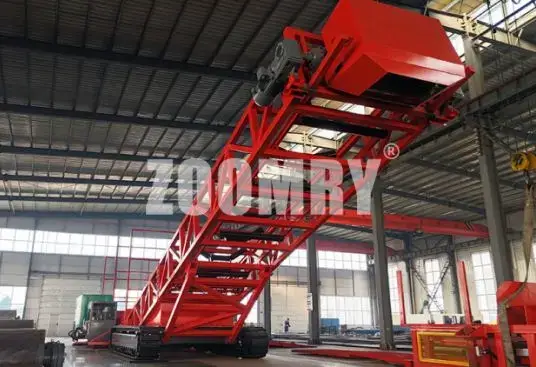Time:2025-04-29 13:53:16 Number of Clicks:
As core equipment in bulk material handling systems, the operational stability of tracked truck unloaders directly impacts material handling efficiency in ports, mines, power plants and other scenarios. With 15 years of expertise in bulk material handling, ZOOMRY Heavy Industry has developed comprehensive maintenance protocols for tracked truck unloaders operating under complex conditions, combining technical specifications with practical logic to support full lifecycle equipment management.

Wear control of moving components relies on scientific lubrication cycle management. During operation, differentiated maintenance strategies should be implemented based on component load characteristics: daily grease replenishment for high-frequency moving parts like track drive gears and hydraulic cylinder joints prevents metal surface friction from oil film rupture; weekly lubrication for radial load-bearing components like slewing rings and roller bearings ensures continuous protective layers; monthly deep maintenance for enclosed structures including gear reducers and tensioning rails involves old oil drainage, filter cleaning and new oil filling, with oil cleanliness meeting ISO 4406 18/16/13 standards.
Lubricant selection must consider operating environments. For high-dust environments exceeding 50°C, use high-temperature grease with ≥180°C dropping point and solid additives to resist oxidation. In subzero conditions below -30°C, synthetic lubricants with <-40°C pour point ensure proper flow. Maintain injection pressure at 20-25MPa for optimal penetration while avoiding seal damage from overfilling.
Download Full Maintenance Manual
[email protected] | +86-13164016717 | ZOOMRY Documentation Center
Implement multi-level structural health monitoring. Conduct daily visual inspections focusing on welds and connections of tracked truck unloaders, particularly in high-stress areas like boom roots and track frame transitions where finite element analysis shows 78% probability of cyclic loading. Quarterly ultrasonic testing for critical welds with detection thresholds of 0.5mm depth or 2mm length. Install strain gauges at stress concentration points for real-time monitoring, triggering alerts when localized stress exceeds 40% of material yield strength.
High-strength bolt preload management directly impacts structural stability. For M24+ bolts, implement staged torque control: initial 50% torque eliminates assembly gaps, 80% achieves preliminary fastening, and 100% optimizes stress distribution. Monitor relative displacement between bolt heads and flanges using marking lines - recalibrate if displacement exceeds 0.1mm.
Design electrical protection systems for dust and humidity resistance. Control cabinets require IP65 rating with 50-100Pa positive pressure ventilation to block dust ingress. Photoelectric sensors employ dual silicone seals and dust covers to block particles >5μm. Motor windings coated with epoxy resin reduce conductive dust adhesion by 85%, preventing short circuits.
For high-humidity/salt spray environments, implement material and structural protections: electrical components with ≥12μm plating pass 2000-hour salt spray tests; silver-plated copper alloy terminals maintain stable contact resistance at >85% humidity; PLC modules integrate humidity sensing and automatic heating to prevent condensation-induced oxidation.
Implement intelligent operational controls with tiered management: conduct 5-minute no-load vibration analysis during startup; adopt three-stage loading (30%/60%/100% capacity) to avoid structural overload; automatic power cutoff and multi-level alarms trigger at 110% overload with fault data recording.
VR-based training simulates 6 critical scenarios including emergency braking and track derailment recovery, teaching hydraulic system protection and electronic fencing. UWB positioning establishes 3m equipment boundaries with automatic speed restriction for collision prevention.
Adapt maintenance to extreme conditions: in subzero temperatures, verify hydraulic oil preheating maintains -25°C to 40°C range and battery output meets starting requirements; rainy conditions require drainage track inspection and 0.5-0.8MPa waterproof sensor testing; high-altitude operations demand daily turbocharger pressure checks ensuring ≥92% rated power output.
Modular design enhances maintenance efficiency: roller assembly disassembly/calibration completes in 45 minutes by verifying ≥80% taper contact; hydraulic valve quick-test ports enable 90% fault diagnosis without pipe disconnection; slide-out PLC modules allow 10-minute replacements with post-installation verification of ≤0.1Ω interface impedance.
For customized maintenance solutions tailored to your operating conditions, contact ZOOMRY technical support. Our multilingual remote guidance and 52-country response network ensure optimal equipment performance.
Copyright © 2002-2024 Zoomry Group Company Limited